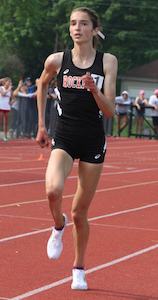
Oak Park Gets Win that Matters Most
June 1, 2019
By Dean Holzwarth
Special for Second Half
KENTWOOD – The Oak Park girls track & field team won the final event of Saturday’s MHSAA Lower Peninsula Division 1 Finals.
That victory in the 1,600 relay was the Knights’ lone victory of the meet. However, a lack of individual winners didn’t prevent them from going back-to-back as overall champions.
Oak Park’s depth was on display as it scored 74 points to win the Finals at East Kentwood High School. Detroit Renaissance took runner-up with 71 points, while Rockford was third with 69.
The Knights have won five Division 1 titles over the last six years.
“A complete team win, and we were solid across the board,” Oak Park coach Brandon Jiles said. “I think it’s the first championship we’ve won where we’ve only won one event, but they placed in everything else so it worked out for us. It was a great meet.”
Oak Park won the 1,600 relay with Jayla Jones, Tamyra Todd, Kourtney Kennard and Chloe Vines in a meet record-breaking time of 3:45.13.
“I’m so humbled and excited,” Vines said. “I’m proud of myself because there are times I don’t think I’m capable of doing certain things, but my teammates trusted me. The girls with me are all underclassmen and they are so motivational and inspiring. They make me want to do great.”
Jiles believed his team had the talent and depth to win even without notching first-place finishes.
“We were really balanced across the board this year,” Jiles said. “We weren’t exceptional in anything, but we were really good in a lot of things.
“It’s a little bit sweeter when you can win a tight battle with two other great teams. Renaissance was outstanding in sprints, and Rockford was amazing with their distance and overall team. I have a lot of respect for those teams, and we had to get the best out of our kids to even think about winning.”
 Rockford senior Ericka VanderLende won the 1,600 (4:41.00) and 3,200 (10.24.57) and finished runner-up in the 800.
Rockford senior Ericka VanderLende won the 1,600 (4:41.00) and 3,200 (10.24.57) and finished runner-up in the 800.
“I was really happy to complete all three events and not completely fall apart at the end, so I could get all the points I could for my team,” VanderLende said. “I was really happy to get two PRs (personal records) and then just come back and finish strong in my last race ever for Rockford.”
VanderLende won the 1,600 a year ago and placed runner-up in the 3,200.
“I just wanted to give it my best effort and go home knowing that I did all I could and laid it all on the line,” VanderLende said.
Her run at three titles was spoiled by Grand Haven senior Gabby Hentemann, who clocked a winning time of 2:08.70 to win the 800.
Hentemann, a senior, missed last year’s Finals due to a foot injury.
“I was in a boot cheering for my teammates last year after suffering a stress fracture,” Hentemann said. “It was a very painful and long recovery, so being able to just race today was a huge opportunity.
“It was very emotional for me to come back and win because my coaches and teammates watched me struggle the past year mentally and physically to recover from this injury.”
Detroit Renaissance freshman Kaila Jackson had an impressive debut and claimed a victory in the 200 (24.04), while finishing runner-up in the 100.
“I wanted to push myself harder after the 100 so I could win the 200,” Jackson said. “Most people get angry, but I build my anger up and take it out on the track. It was a great experience for my first state meet with the crowd and all the other runners. We pushed each other, and it was amazing.”
Jackson’s teammate, Leeah Burr, won the 400 in a time of 54.17.
White Lake Lakeland’s Grace Stark repeated in the 100 hurdles (13.43).
Other individual winners included: East Kentwood’s Qe’Neisha Young (100), Troy’s Lauren Fulcher (300 hurdles), East Kentwood’s Belle Okoroafo (discus), Dexter’s Nicole Bow (pole vault), Okemos’ Jasmine Clerkley (shot put), Mona Shores’ Elizabeth Knoll (high jump) and Walled Lake Western’s Kennedy Jackson (long jump).
PHOTOS: (Top) Oak Park celebrates its fifth Lower Peninsula Division 1 championship over the last six seasons. (Middle) Rockford's Ericka VanderLende capped her high school career with two more individual titles. (Photos by Carter Sherline. Click to see more from RunMichigan.com.)

Track Gaining Speed Toward Future with Electronic Starting Devices
By
Steve Vedder
Special for MHSAA.com
May 23, 2023
Aubrey Greenfield thinks it might be the perfect time to reevaluate 130 years of tradition.
For a number of reasons, from technical to personal, the Oxford senior sprinter believes it makes sense for the crack of a starting pistol to be eliminated from high school track meets.
Because track meets would benefit in various ways from lowering costs to easier setup at meets to the human factor of competitors not having to flinch at the crack of a pistol shot, Greenfield believes the sport has a chance to embrace new technology – electronic starting devices (ESD).
In essence, an ESD replaces the starting pistol with a light flash, tone sound or both to begin a race.
"High school sports should put the athlete first," Greenfield said. "We should promote sports, and eliminating starting pistols promotes health in terms of PTSD or trauma for athletes and spectators and that would be good. I would like to think people would say that's a good idea."
In fact, Greenfield would go as far as to say if there was not an implementation of electronic starting devices, many of her teammates would have considered giving up the sport.
"If it's something that helps us compete safely, we're all for it," she said.
Greenfield's opinion apparently is spreading. Michigan High School Athletic Association senior assistant director Cody Inglis said the use of ESD makes it both affordable for meet starters and sensible for athletes and fans to rethink the use of starting pistols. While the MHSAA is not mandating electronic starting devices, it does promote the use of what Inglis calls "emerging technology." He notes that ESD are becoming the norm for organizations such as USA Track & Field, the NCAA and an increasing number of high schools.
 "I think we have to embrace new technology, and we think this will be something that takes hold," Inglis said.
"I think we have to embrace new technology, and we think this will be something that takes hold," Inglis said.
A key part of embracing ESD is the human element. The tragic Oxford High School shooting Nov. 30, 2021, that took the lives of four students while injuring seven others should not be relived even for a fleeting instance at a high school sporting event. Oxford athletic director Tony DeMare said the school began using ESD at every meet, including the MHSAA Lower Peninsula Division 1 Finals last June. He said that decision was embraced by virtually all schools Oxford encountered.
"We were very convinced that the alternative (of ESD) would promote a healthy attitude," DeMare said. "We were overwhelmed with the positive response. If a school was on the fence about it or might not be for it, I think we've started to see the tide turn in favor of people willing to listen and learn about electronic starting devices."
Inglis said the MHSAA is acutely aware of what the crack of a starting pistol can mean to athletes and fans.
"It's unimaginable what Oxford went through, and this is a small way we can help," he said. "We look at a (starting pistol) and think, ‘Could we do something else?’ It's a way of helping to solve a problem."
Over the last several years, the MHSAA has embraced finding an alternative to starting pistols. Inglis noted the discussion started with the cost and diminishing availability of 32-caliber ammunition that meet starters use. A box of ammunition, if it can be found, is around $75 a box.
In addition to cost, there is potential damage from excessive exposure to 150-plus decibels of sound generated by the traditional 32-caliber blanks. Medical studies show damage to ears caused by decibel levels above 120 dB.
The tragedy at Oxford accelerated the conversation.
Inglis said the cost of ESD can be likened to a school sinking money into artificial surfaces at football fields. Yes, there is a great cost at first, but over time money is ultimately saved. An ESD system itself ranges between $200 and $500. Speakers also may need to be purchased, but with ESD starting events like the 800 and 1,600-meter relays positioned near the outside lanes 8, 7, 6 and 5 would result in improved hearing by athletes at the start of a race.
There is one challenge with ESD that track administrators are working to overcome – lighting conditions that lessen the ability to see the ESD’s LED light or strobe when the button is pressed by a starter to begin a race. But that vision difficulty resulting from clear blue skies and backgrounds of setting suns can be substantially improved by incorporating a black background with an ESD – something as simple as a starter holding up black cardboard behind the lighting mechanism at the start of an event.
Inglis said when all factors are considered, the use of ESD makes sense.
 "With the climate we live in nowadays, no lookalike guns is good," he said. "We're not mandating this. But people are saying this is affordable."
"With the climate we live in nowadays, no lookalike guns is good," he said. "We're not mandating this. But people are saying this is affordable."
While switching to ESD would break 130 years of tradition, the timing could be a step forward, said Jeff Hollobaugh, co-author of the book "The Fleet Feet of Spring: Michigan's High School State Championships in Track & Field." He said while no definitive answer is possible, it's likely starting pistols were used at the inaugural state meet at the Jackson Fairgounds in 1895. The meet, which included events like tossing a 16-pound shot put, bike races and a 100-meter sprint, was sponsored by the Michigan Interscholastic Athletic Association (a predecessor to the MHSAA) and comprised mostly of the state's larger schools.
Hollobaugh's sentiments echo what many involved in today's high school track & field believe in terms of making a transition from starting pistols to electronic starting devices.
"It's a change, not necessarily good or bad, just different," he said. "It's not a drastic change, but it will take some getting used to. But it is the future. In the end, we'll all be fine."
DeMare believes the future of high school track will definitely include ESD.
"Our desire is that the practicality and sensibility of this will overcome the alternative," he said. "I think we'll see the automation and electronics taking hold of certain elements in track, and people will embrace it."
PHOTOS (Top) Runners watch official Bertha Smiley as they prepare to begin a race during last season's Lower Peninsula Division 1 Finals at Rockford. (Middle) An electronic starting device provided by VS Athletics was used to start those races. (Below) Smiley sets to begin an event. (Photos provided by David Kuderka/VS Athletics.)

